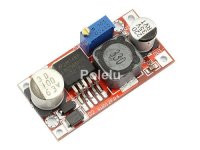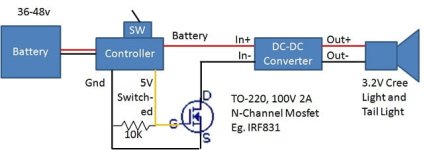hardym
100 W
Here's a way to add cheap, but powerful head and tail light to your 36 or 48 volt system for under $50.
Start with this Cree light package from ebay for $30. This is a Super bright light that has more than enuf power for night rides. It Includes a small battery pack that you will not need. http://www.ebay.com/itm/261129243438?ssPageName=STRK:MEWNX:IT&_trksid=p3984.m1497.l2649

Add in this DC-DC converter $4.99 + shipping. http://www.ebay.com/itm/300810925667?ssPageName=STRK:MEWNX:IT&_trksid=p3984.m1497.l2649

Any variant DC-DC converter is fine, but make sure you get the LM2596HV (HV= High voltage). One with a built-in cooling fins may be better
Adjust the Dc-DC converter down to about 3.2 volts. This seems to reduce the overall power consumption of the converter when used with the light. I've encased the DC-DC converter in shrinkwrap.
I have a switch on my controller, and the inrush current on the DC-DC blew out the switch. So, I soldered a T0-220 N-FET to the neg input lead of the DC-DC converter, and use the controller's 5V supply to the Gate of the mosfet. This allows the 5V line to turn on the Dc-Dc converter. I included a 10K resistor between the Gate and Gnd to help the MOSFET turn off.

View attachment 1
For the tail light, I manually soldered all the leds in parallel (bypassing the built in control circuit) and then to a 100 ohm resistor in series to the DC-DC converter output. The Tail light is on whenever the controller is on, which is nice.
Mark.
Start with this Cree light package from ebay for $30. This is a Super bright light that has more than enuf power for night rides. It Includes a small battery pack that you will not need. http://www.ebay.com/itm/261129243438?ssPageName=STRK:MEWNX:IT&_trksid=p3984.m1497.l2649

Add in this DC-DC converter $4.99 + shipping. http://www.ebay.com/itm/300810925667?ssPageName=STRK:MEWNX:IT&_trksid=p3984.m1497.l2649

Any variant DC-DC converter is fine, but make sure you get the LM2596HV (HV= High voltage). One with a built-in cooling fins may be better
Adjust the Dc-DC converter down to about 3.2 volts. This seems to reduce the overall power consumption of the converter when used with the light. I've encased the DC-DC converter in shrinkwrap.
I have a switch on my controller, and the inrush current on the DC-DC blew out the switch. So, I soldered a T0-220 N-FET to the neg input lead of the DC-DC converter, and use the controller's 5V supply to the Gate of the mosfet. This allows the 5V line to turn on the Dc-Dc converter. I included a 10K resistor between the Gate and Gnd to help the MOSFET turn off.

View attachment 1
For the tail light, I manually soldered all the leds in parallel (bypassing the built in control circuit) and then to a 100 ohm resistor in series to the DC-DC converter output. The Tail light is on whenever the controller is on, which is nice.
Mark.



